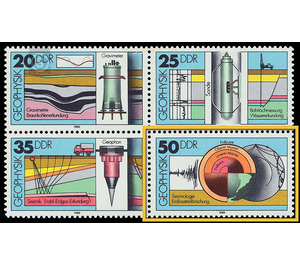geophysics - Germany / German Democratic Republic 1980 - 50 Pfennig
Theme: Devices, Items & Instruments
| Country | Germany / German Democratic Republic |
| Issue Date | 1980 |
| Face Value | 50.00 |
| Color | multi-colored blue |
| Perforation | K 13:12 1/2 |
| Printing Type | offset |
| Stamp Type | Postage stamp |
| Item Type | Stamp |
| Chronological Issue Number | 2302 |
| Chronological Chapter | GER-DDR |
| SID | 545583 |
| In 10 Wishlists | |
Geophysics The Ministry of Posts and Telecommunications of the German Democratic Republic publishes four multicolored special postage stamps on the subject of geophysics. In geological exploration, geophysical measurements on the surface of the earth and in well-drilled wells (well logging) play an important role today, especially with regard to reducing the costly drilling that is still required. The numerous methods used are based on the utilization of natural and artificial physical fields (eg gravitational and magnetic field of the earth, generated electric and acoustic fields) as well as the different physical properties (eg density, magnetic susceptibility, electrical conductivity, propagation velocity of sound waves) of the different rock types. In this case, even with modern electronic measuring devices and data processing on powerful computers usually only indirect statements about possible deposits can be obtained. The most significant benefit of geophysical results is the potential optimization of well approaches and the increase in information yield from wells. The geological industry and the mining industry of the GDR use geophysics as one of the most important means of rationalization in the forced exploration and promotion of domestic raw materials. By far the greater part of all field and borehole geophysical work in the GDR is provided by the VEB Geophysik Leipzig, which also develops and produces the majority of the necessary measuring equipment. The fulfillment of the planned tasks of this enterprise is significantly promoted by the direct support of Soviet specialists as well as by a manifold cooperation with partner institutions in the USSR and other socialist countries as well as academy and higher education institutions of the GDR. 50 Pfennig Seismology / Secrust Research Seismology as a branch of pure or general geophysics - whose research object is the earth as a whole - originally dealt only with the instrumental observation and with the study of the causes, mechanisms and manifestations of earthquakes. In the course of scientific development, the use of earthquakes as a means to investigate the structure of the earth, but especially the structure of the earth's crust and upper mantle, was added as a special direction. The seismology carried out in the GDR on academy and higher education institutions has thus become an essential instrument of earth crust research, which in turn represents an important link to the raw material-oriented, industrially operated geophysical exploration. In addition to a seismogram detail, the brand motif contains the shell model of the earth and a scheme of seismic wave propagation in crust and mantle.


